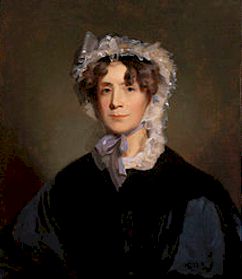|
 |

Part of the American
History & Genealogy Project |
Martha (Patsy) Jefferson Randolph 1772 ~ 1836


Martha (Patsy) Jefferson Randolph
Perhaps no better reason why the biography of Martha Jefferson
is important can be given than the following estimate of her,
found in a history of our young Republic: "As a child, she was
her father's only comforter in the great sorrows of his life, in
matured years she was his intimate friend and companion; her
presence lent to his home its greatest charm, and her love and
sympathy were his greatest solace in the troubles which clouded
the evening of his life."
Thomas Jefferson, going, a lonely widower, on his first mission
to France, took with him his little girl, "Patsy," as he
lovingly called her, and while she was placed in a convent his
regular and constant visits to her there brought all the comfort
and happiness of life to both of them. She was only ten years
old at the time of her mother's death in 1782, but her own
sorrow was almost forgotten in the contemplation which was
constantly before her of that greater sorrow of her father. She
understood it when, one night, she entered her father's room,
and found him giving away to a paroxysm of weeping.
But her father would not allow her young life to be shrouded in
gloom, and later on, when she was sixteen, she entered with him
the world of Paris, and was introduced into the brilliant court
of Louis XVI. In spite of her youth and her modest, retiring
disposition, she was considered a remarkable young woman. She
did credit to the excellent education she had received. She was
found to be a good elocutionist, an accomplished musician, and
one well versed in matters historical. She was not beautiful
(and perhaps it is a relief to learn that she was not, after
hearing about so many dames and daughters of a bygone day whose
wondrous fairness is forever being told in story and rehearsed
in song), but she is reputed to have been "tall and stately" and
to have had an interesting rather than a pretty face.
Hints of Miss Patsy's good times and of the interesting people
whom she met when she was a debutante in the Paris world have
come down to us. We read of her acquaintance with the gay and
gallant Marquis de La Fayette, who never chanced to meet the
daughter of Thomas Jefferson without pausing to exchange a few
merry words with her; and of her enthusiastic admiration for
Madame de Stael, whom she saw very often in society, and to
whose wonderful conversation she invariably listened
attentively. But Martha Jefferson loved her country and her
father too truly to think of deserting them for the sake of any
gallant of King Louis' court. Moreover, she knew that in her own
country there was waiting for her someone infinitely superior to
anyone she might meet abroad.
When, in 1789, she and her father and her sister returned to
their beloved Virginia home, Monticello, she met again this
second cousin, Thomas Mann Randolph, who had been her childhood
sweetheart, and on the 23rd of February, 1790, "Miss Patsy," as
she was called, and her cousin Tom were married. She was happy
in her husband a man, so Jefferson tells us, "of science, sense,
virtue, and competence." With him she led an ideal family life.
Her home, at Edgehill, the Randolph estate, from which, in the
winter, when the trees were bare, she could see the glimmer of
the white columns of the portico of Monticello, became filled
with a host of little people. There were twelve in all, five
sons and seven daughters, all equally lovable and interesting in
their mother's eyes. But the most enjoyable times of Mrs.
Randolph's life were the July vacation months when, with the
coming of summer. President Jefferson, tired of Washington and
the affairs of state, retired to Virginia and, stopping enroute
at Edgehill, picked up the whole Randolph family, and carried
them off with him to Monticello.
When Thomas Jefferson became President, Mrs. Randolph and her
sister came from the obscurity of their Virginia homes, and
began their reign in the White House. The two sisters took by
storm the Capital of the nation. For the first time since their
girlhood days in Paris at the court of Louis XVI they became a
part of the gay world. During that winter at the President's
home Mrs. Randolph was very happy entertaining her father's
distinguished guests and taking part in all the gayeties of the
Capital. She was everywhere admired. The Marquis de Yrcijo, who
was then Spanish Ambassador in Washington, declared that she was
fitted to grace any court in Europe, and John Randolph, of
Roanoke, was so impressed with the beauty of her mind and
character that years after, when her health was proposed at a
gentleman's table in Virginia, at a time when "Crusty John"
himself was one of her father's bitterest political foes,
seconded the toast with the exclamation, "Yes, gentlemen, let us
drink to the noblest woman in Virginia."
In the spring that followed this winter of memorable pleasures
and excitements Mrs. Randolph, with her young family, withdrew
from Washington society, and returned to live in the utmost
simplicity at her home at Edgehill. It was a glorious time for
Mrs. Randolph when, at last, the adored father returned to her,
not as President of the United States, on a hurried visit to his
home and family, but as a simple country gentleman, who was
never again to be deprived of that domestic peace and harmony
for which he had sighed so many years. When he came this time
the removal to Monticello was permanent. For the remainder of
his life Jefferson and his daughter and his daughter's children
lived happily on the summit of the little mountain, in the home
that was so dear to them all.
Her father's death and the loss also of his home, which came of
the too generous hospitality which always existed at Monticello,
broke Martha Jefferson's heart. The troubles that followed her
husband's death, and the worries and vexations of poverty found
her resigned, almost unmoved. She passed her last days in
visiting among her children. It was at Edgehill, the home of her
eldest son, Jefferson, that she was best contented, because of
the proximity to Monticello. From a window of the room that was
always reserved for her she could look up through the trees and
across the meadow to Monticello. Here, in sight of the loved
home, she lived over again in memory the associations and
happiness she had once enjoyed.
Martha Wayles Jefferson
Women of
America

Source: The Part Taken by Women in
American History, By Mrs. John A. Logan, Published by The Perry-Nalle
Publishing Company, Wilmington, Delaware, 1912.
|